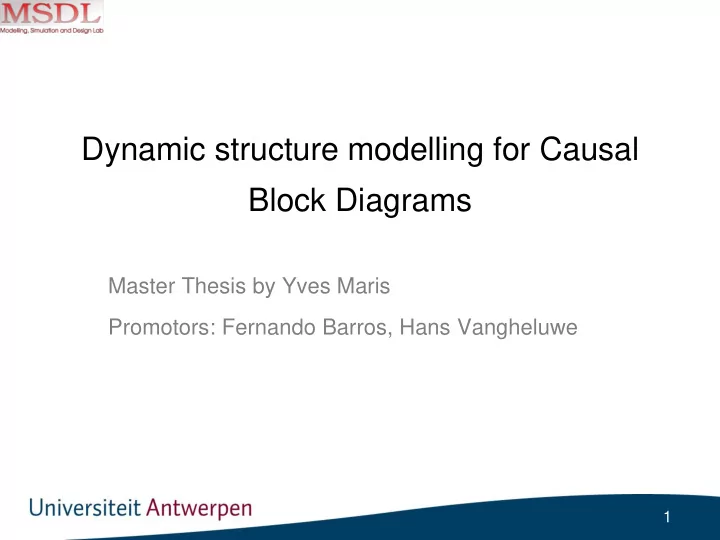

Dynamic structure modelling for Causal Block Diagrams Master Thesis by Yves Maris Promotors: Fernando Barros, Hans Vangheluwe 1
Overview – Background: Causal Block Diagrams – Syntax – Semantics – Problem statement – Dynamic structure CBD – Syntax – Semantics – Implementation – Case study: elevator model 2
Overview – Background: Causal Block Diagrams (CBD) – Syntax – Semantics – Problem statement – Dynamic structure CBD – Syntax – Semantics – Implementation – Case study: elevator model 3
Causal Block Diagrams Abstract Syntax 4
Causal Block Diagrams Visual Syntax 5
Overview – Background: Causal Block Diagrams (CBD) – Syntax – Semantics – Problem statement – Dynamic structure CBD – Syntax – Semantics – Implementation – Case study: elevator model 6
Causal Block Diagrams semantics 7
Background: flattening – Purely syntactical – Needed for loop detection 8
Background: Evaluation Order – Dependenties beween blocks – Topological sort 9
Loop detection – Strong component algorithm – Use gausian solver for implicit solution 10
Overview – Background: Causal Block Diagrams (CBD) – Syntax – Semantics – Problem statement – Dynamic structure CBD – Syntax – Semantics – Implementation – Case study: elevator model 11
Problem Statement – Expressiveness limited by fixed structure – Changing model during simulation – Staying consistent with CBD constructs 12
Schedule – Background: Causal Block Diagrams – Problem statement – Dynamic structure CBD – Syntax – Semantics – Implementation – Case study: elevator model 13
Abstract Syntax 14
Visual syntax: explicit representation – Reuse of existing graph transformation syntax – Left-hand side before – Right-hand side after – Trigger trough input port 15
Visual syntax: implicit representation – Trigger received trough CBD input port – Added structures: green – Removed structures: red 16
Visual syntax: hybrid representation – Mix between implicit and explicit representation – Implicit representation separated by block – Simulated model isolated 17
Visual syntax: comparison – Implicit representation not expressive enough – Hybrid representation – Same expressiveness as explicit representation – More compact 18
Overview – Background: Causal Block Diagrams (CBD) – Syntax – Semantics – Problem statement – Dynamic structure CBD – Visual syntax – Semantics – Implementation – Case study: elevator model 19
Related work – Hybrid CBD – Mustafiz, Sadaf, et al. "Towards Modular Language Design Using Language Fragments: The Hybrid Systems Case Study." Information Technology: New Generations . Springer International Publishing, 2016. 785-797. – Uses signal crossing – Dynamic structure DEVS (DSDEVS) – Barros, Fernando J. "Modeling formalisms for dynamic structure systems." ACM Transactions on Modeling and Computer Simulation (TOMACS) 7.4 (1997): 501-515. – Heterogeneous flow systems – Barros, Fernando J. "Dynamic structure multiparadigm modeling and simulation." ACM Transactions on Modeling and Computer Simulation (TOMACS) 13.3 (2003): 259-275. – Use of model executive 20
Triggering a change: zero crossing – Piecewise constant signal to “event” – Pre and post condition – Implemented using basic blocks 21
Triggering a change: zero crossing – Signal must cross zero from below – Previous iteration: condition must be not satisfied – Current iteration: condition must be satisfied 22
Triggering a change: timed event – Generating “event” after a fixed number of timesteps – Value determined when intialised 23
Modeling a change: structure block – Features of a dynamic structure formalism – Identification of existing structures – Creation of new structures – Removal of existing structures – Initialisation of values 24
Modeling a change: structure block – Structure block = adapted CBD specification – Structure function for modelling change – Multiple input/ no output ports – Default 1: event that triggers a change – Other input ports for initialisation of values – Changes apply only to one CBD! (hierarchical) 25
Modeling a change: examples 26
Modeling a change: examples 27
Adapted operational semantics 28
Overview – Background: Causal Block Diagrams (CBD) – Syntax – Semantics – Problem statement – Dynamic structure CBD – Syntax – Semantics – Implementation – Case study: elevator model 29
Implementation 30
Implementation: AToMPM – Visual modeling enviroment 31
Metadepth – Exported AToMPM model using built in functionality – Supports EGL for code generation 32
XML – Readable models – Consistent declarations – Remove tags 33
Python – Parser generates code including structure functions – Simulator implemented in python – Extended CBD simulator from MOSIS course 34
Debugging – Test driven development – Traces 35
Overview – Background: Causal Block Diagrams (CBD) – Syntax – Semantics – Problem statement – Dynamic structure CBD – Syntax – Semantics – Implementation – Case study: elevator model 36
Case Study – Balls in elevator – Doors open when elevator reaches floor – Balls can enter and leave elevator trough door 37
Modeling a Ball 38
Position with constant velocity 39
Position with constant acceleration 40
Velocity CBD for elevator wall 41
Demo 42
Execution plots 43
Execution plots 44
Execution plots 45
Future work – Advanced scheduling of structure blocks – Optimisation techniques – Comparison to other methods (hybrid systems) 46
Questions? 47
Recommend
More recommend